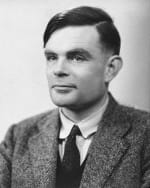
Born June 23rd, 1912 in London, England, Turing displayed a penchant for math at an early age. He attended Kings College, Cambridge, and Princeton, where he earned a Ph.D. in mathematics. He published “On Computable Numbers” in 1936, which established the theoretical foundations of digital, stored-program computing. During WWII he worked for the British government cracking the German Enigma code and assisting in the construction of the Colossus, the first operational electronic computer.
Eccentric and colorful, he rode a bicycle everywhere (even when it rained) and often wore a gas mask to control hay fever. He was also a long distance runner and would’ve been a contender in the 1948 Olympics if it hadn’t been for a serious injury. After the war he turned his attention to artificial intelligence, inventing what is now called the Turing test, which was used to judge whether a machine was considered intelligent. He was also openly gay, which was looked upon with disdain at the time and earned him some serious prosecution. Turing went on to study the chemical and mathematical basis for the formation of asymmetrical patterns in biology. He was found dead on June 7th, 1954 at his home, victim of an apparent suicide.
